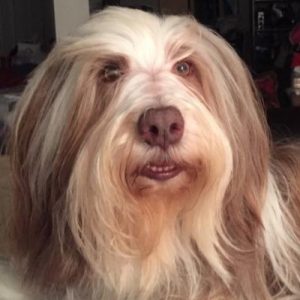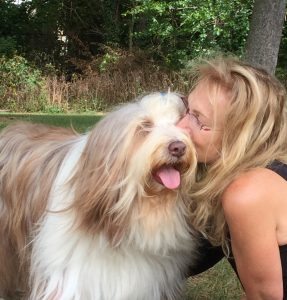By Margo Patrick
*This post is a selected entry from the Pet Professional Guild Writers’ Competition for Geek Week 2020*

Bearded collie Carly became fearful and reactive after a negative training experience at a dog show © Margo Patrick
My goal is to educate and facilitate health, wellness and communication through building or repairing the relationship known as the human animal bond, utilizing principles and standards derived from my first professional career as a registered nurse and my certifications in human animal intervention and, soon, applied canine ethology.
I employ a dynamic, multidisciplinary force free approach involving overlapping principles of behavior, ethology, core emotions and emotional affect space.
I believe that without care, compassion and accountability for our human actions, the human animal bond with any other species, is in danger of being deconstructed.
Those of us who are involved in communication with other species, seem to experience a moment where the universe slips us our ”tipping point” in the form of the one animal companion who will bring out our finest moments.
New Dog
I wasn’t looking to add a new dog to my family when Carly came into our lives. Carly became the embodiment of my mission and the first to benefit applying my nursing perspective and approach to human animal intervention.
When constructing care plans for healing, training and relationship building, I incorporate lure coursing as one of my goals for play. This proved to be pretty intricate and when I thought of giving up, Carly and (neuroscientist) Jaak Panksepp’s work encouraged me to ”Keep Seeking Your Own Welcome Self.”
Carly is my gorgeous 13-year-old bearded collie. Carly is a winner against all odds. After starting behind the 8 ball, fearful because her siblings bullied her, she blossomed into a patient perfect mom to her own and others’ puppies.
Her herding instincts were ever present and she would watch over and herd all puppies, rabbits, and even the land tortoise. She was protective of our family but generally reserved at gatherings or in public, preferring to oversee and gather up stragglers.
Shut Down Dog

Carly with her guardian © Margo Patrick
The problems started when I made the grievous error of sending her to a few dog shows with a highly acclaimed and successful handler. At the end of her second solo trip, I went to see her in the ring and witnessed her beauty in motion.
She left that ring with a ribbon and points and I thought Carly’s quiet greeting to me was good behavior. I was horrified when the handler explained that to have some other dogs run properly, the slip collar has them ”within an inch of their life.”
She stood quietly at my side as I spoke with important breeders and guardians, called my partners and left to drive home with my friend who also commented on her subdued greeting and demeanor.
Carly returned home from that show completely different, a shut down, obviously traumatized, fearful dog.
Now, when Carly became excited she was unpredictable. An appropriate social interaction could be triggered into her displacing with a PTSD aggressive behavior. One moment Carly would be approaching a person in her calm but alert way, then she would jump back, moving away in a low crouch.
I would be giving her the space to leave, and she would turn away, but then with lightning speed, Carly would turn back freeze, lunge, bite.
I was a divorced mother of two teenagers and three intact bitches: Abigail a soft coated wheaten terrier, Carly, the bearded collie, and Tess, a Havanese. We also lived with two bunnies, fish, three birds and a land tortoise.
I worked full-time as an operating room register nurse in a level one trauma center, my children were in two different schools and my ex-husband and most of my family moved out of state.
Life was very busy with the kids’ activities, dog shows, competitions and breeding and whelping schedules. Each dog took on her own breed appropriate set of responsibilities but everything flowed well. Not for long, however…
Hurricane Sandy

Carly’s guardian worked with her to desensitize and recondition her reactions to her fears © Margo Patrick/CC
Hurricane Sandy destroyed my backyard and shelved plans for a career change. The stress was mounting. Abigail, Tess’s buffer between herself and Carly, moved out to go to college with my son.
My daughter moved closer to her university. Carly began redirecting aggressively when Tess would taunt her with her clownish Ninja antics.
Not realizing that he was compounding the social and behavioral problems, a friend who walked Carly judiciously kept her on a tight leash when they approached any other dogs, loud cars or people to avoid triggering a reaction.
Poor Carly. Now she missed her best friend, she had a bothersome little sister, and a dog walker who didn’t understand her need to get away from something she feared.
I was very aware of her issues but I was also overwhelmed, selling the house, always busy and clueless about the best way to ground us.
Looking back, I relate to Carly surviving the chaos in the midst of a tornado on her own, just as I had when I was a child. The difference was that I never took the opportunity to sink my teeth into a younger sibling’s neck and shake her like a rag doll.
Equine Therapy
We were fortunate that, at the time, I was experiencing the healing of equine therapy. Playing, walking and talking and information processing, I became familiar with my own self with little awareness of discomfort due to the release of the neurochemicals and hormones during a playful exercise. I thought this would be great for Carly.
I searched and discovered the certification program in human-animal interaction at Rochester University, New York. This is where I realized just how much work there was to be done to help Carly and other dogs and children. I also found out how much additional education and work I would need to do to complete my certificate in applied canine ethology so I could contribute to evidence based scientific research and to present it back to professional nursing.
More to the point, I realized how similar Carly and I are. We both are experts at planning resource finding, anticipating needs and next moves, implementing, assessing , regrouping and redirecting, multitasking, taking charge, and leading. We can both like being in control and educating and can be catty and crying with fear and angst while moving forward with compassion.
Applying Play
The fact that all species of mammals utilize play at different developmental stages of their lives, for more than releasing pent-up energy, gave me hope for working out more of Carly’s and my own fear of just being ourselves.
In addition to practicing skills, enhancing cognitive development and recognizing face and body language, play has been shown by researchers to stimulate the synthesis of neurochemicals in all species which enable individuals to tolerate specific levels of stress, and even thrive, during these life lessons. I believe the reason play works so well is its diverse application when discussing an evolutionary stable strategy (ESS).
Just ask Carly. I learned how to work with her to desensitize and recondition her reactions to her fears. I have found that each dog has a special way of allowing you to help.
I find that whatever I try, my timing has to be aligned with the dog’s temperament. I shape the activity and training around what the dog can handle.
For Carly, I began with “touch “ and “look at me” at home then when we went out. She was the queen of look at me before the scary thing and treating during the stimulus duration. Then she grew to seeing the scary thing and checking in with me. Now I get a side glance but she moves on, or blocks me and sniffs the grass letting me know something’s up. If I am distracted she will touch me with her nose to tell me she needs me (“pay attention, the thing is here”).
I had her back without fail. We met neighbors and store owners and people everywhere.
Today, Carly makes the choice to politely approach someone she finds interesting, on her own. She also has many dog friends.
Why lure coursing? Who do you think answered this ? Was it me, Carly or both of us?
I look into their eyes and process what I see in their soul.
I watch each individual move, on their own or together.
As I watch each individual begin to move in ways natural and instinctive to their species, I begin to feel what they are experiencing. I hear with my ears while I listen with my heart. I give them the opportunity of emotional and physical space to demonstrate what they need in order to be able to enjoy their freedom and to play.
My goal is to enable everyone to feel empowered to “Keep Seeking Your Own Welcome Self.”
About the Author
Margo Yagid Patrick of Keep Seeking Lure Coursing LLC is a registered nurse of 36 years, and holds a bachelor’s in nursing and a certificate in human animal intervention from the Rochester University Nursing School (Amy Johnson) program. She is currently working towards her certificate in applied canine ethology with the Ethology Institute (Roger Abrantes) and I has also studied (PPG corporate partner) Dr. Karolina Westlund’s animal emotions program, where she covers the Core Emotions as defined by Panksepp. She is also a lure course operator and a yoga instructor.
